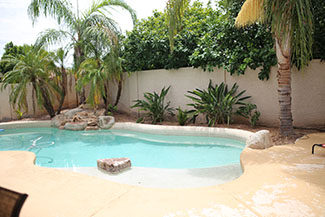https://old.rosieonthehouse.com/faqs/water-conservation-in-arizona
Water Conservation in Arizona
WATER SAVING TIPS AND TECHNOLOGIES | POOLS AND SPAS
Did you know that about 70% of residential potable water in Arizona is used outdoors? Pools and spas are responsible for approximately 16% of outdoor water use.
In Arizona, a standard (16 ft. X 36 ft.) uncovered pool loses four to six feet per year to evaporation, most of which occurs during the summer. Added to the water lost during refilling and backwashing, that's roughly the equivalent of filling the pool every year. Draining a pool doubles this amount!

Designing a Water Conscience Pool
When designing your pool, follow these simple guidelines to help reduce water waste, keep your pool clean, and save money and time:
- Design the overflow pipe so it can be plugged or blocked easily when large groups are swimming. This prevents water loss due to splashing water.
- Make sure that splash troughs drain back into the pool system.
- Seven mph winds over the pool's surface area can increase evaporation losses in 300%! Use windbreaks such as fences, trees and shrubs to reduce evaporative losses. Choose low water use plants to save even more water.
- In Arizona's desert regions, pool covers drastically reduce evaporation, but also tend to retain heat. Consider a reflective pool cover to curb the heat retention of the water, keeping it at a comfortable temperature for swimming. Using a retractable pool cover adds an extra measure of safety for kids and pets.
ALWAYS WATCH CHILDREN AROUND ALL WATER.
Operating and Maintaining a Water Conscience Pool
Filling:
- Monitor pool filling. Don't let it overflow! Meter the water that refills the pool; if you notice a sharp increase in water, you may have a leak.
- Don't overfill the pool. Keep the water level lower to reduce water loss due to splashing.
Filters and Backwashing:
- Reduce the need for backwashing by using cartridge filters instead of sand filters. Cartridge filters can be dismantled and cleaned without having to backwash.
- If your filter needs backwashing, choose one that includes a pressure drop gauge. This will help you determine when the pool needs to be backwashed and when it doesn't. Find one with a sight glass so that it is easy to determine when to stop the backwash cycle.
- Conduct routine water quality tests. This will reduce the number of backwashes needed and will save time, effort, and money in the long run.
- Don't let good water go to waste! Direct the filter backwash water to plants or use for
- other beneficial purposes. Don't let water run into the streets or on sidewalks.
Draining:
- Swimming pools and spas seldom need to be drained. However, if yours does, follow these steps:
- Neutralize the acids and do not use chemicals for 72 hours prior to draining.
- Redirect water to plants or use in some other beneficial way. Make sure the plants are chlorine tolerant before watering with pool water.
- Spas should not be drained more than once every three to six months.
- If you live in a cold climate, instead of draining your pool in winter to keep it from freezing, use ice compensating technologies, such as winterizing chemical kits sold at pool stores.
Pumps:
- Use smaller, high-efficient pumps. A 0.75 horsepower pump is sufficient for most residential pools. Smaller pumps result in additional savings, if you substitute a larger filter, increase the diameter or decrease the length of the pipes, or replace 90-degree elbows with 45-degree elbows or flexible pipe. Solar pumps are now available on the market.
- Run pumps for no longer than 3 hours a day, and save both energy and money.
###
Credits:
RELATED CONTENT:
- Arizona Department of Water Resources: Pools and Spas | Water Saving Tips and Technologies
- Arizona Department of Water Resources: Water Conservation Tips for Arizona Residents
